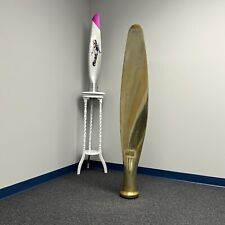
Sumitomo Hamilton WWII cs-3b Mitsubishi G4M Japanese Airplane Propeller Blade For Sale

When you click on links to various merchants on this site and make a purchase, this can result in this site earning a commission. Affiliate programs and affiliations include, but are not limited to, the eBay Partner Network.
Sumitomo Hamilton WWII cs-3b Mitsubishi G4M Japanese Airplane Propeller Blade:
$7500.00
One of a kind Airplane Propeller Blade from the Estate of POW Colonel Frank H. Collins. Off of a Mitsubishi G4M Bomber and signed by the members of the WWII 503rd AFF Base Unit.
About the Propeller Blade
This is a Hamilton Standard Licensed propeller manufactured by the Propeller Division of Sumitomo Metal Industries in Japan during WWII. The decision to license these propellers to Japan prior to WWIIwas motivated by Hamilton Standard'sdesire to expand its business and generate revenue, as well as to promote international cooperation and peace.At the time, the United States and Japan had not yet become enemies, and there was hope that economic ties between the two countries could help prevent war.
However, as tensions between the United States and Japan increased in the years leading up to the war, the decision to license propeller technology to Japan came under scrutiny. Some critics accused Hamilton Standard of helping Japan build a stronger military, while others argued that the company should have been more cautious in sharing its technology with a potentially hostile nation.
Overall, the decision to license propeller technology to Japan during World War II remains a controversial and complex issue, with various factors contributing to the decision-making process at the time.
Propeller stands 64 inches tall x 11 inches wide.
Propeller was polished and then anodized in gold (Some anodize has come off over the years)
Signed with an electric engraver by members of the 503rd AAF Base Unit and presented to their commander Colonel Frank H. Collins on June 2nd 1945.Stampings on propeller include: MFG-K33669,DWG-CS-3B, N280-37B, Japanese symbols.
There is also a taped on Japanese written tag (Crumbling apart) that also showed this blade being from a G4M.About Colonel Frank H. Collins
Frank Collins (1918-2000)was a decorated U.S. Army Air Forces pilot who served in World War II and the early years of the U.S. Air Force. Born in Caddo, Texas, he enlisted in 1934, attended Texas Wesleyan College, and then joined the Aviation Cadet Program in 1942. Collins served as a pilot in the 319th Fighter Squadron and later as a commander in the 464th Fighter Squadron. During his career, he was credited with destroying nine enemy aircraft, becoming a prisoner of war in Japan, and testing jet aircraft. Collins also served as a base commander at Edwards AFB, an advisor to the Ohio Air National Guard, and held various leadership roles in the 21st Tactical Fighter Wing, the 39th Air Division, the 31st Tactical Fighter Wing, and the 366th Tactical Fighter Wing. He retired in 1967 as Commander of the 836th Air Division at MacDill AFB, Florida.
AbouttheSignatures on Blade
The signatures on this blade are absolutely gorgeous. I'm amazed they were able to sign their names so perfectly and all in a line. Would love to know which engraver they used for this. Afteridentifying as many names as we could we found (2) that particularly stood out(Charles Rogers and Joseph E. Kimm).
Charles Rodgers(December 30, 1921 – disappeared June 23, 1965) was an American seismologist, pilot, and murder suspect who disappeared in June 1965 after police discovered the dismembered bodies of his elderly parents in the refrigerator of the Houston home all three shared, in what the media later dubbed "The Icebox Murders". Rogers has never been found and was declared dead in absentia in July 1975. He remains the only suspect in the murders, which are still considered unsolved.
Joseph E. Kimm(August 18,1911-September 19, 2013) an aviation pioneer. In 1933 he co-piloted Amelia Earhart's Northwest Airways Survey Flight.Amelia Earhart rode along as an observer on a Northwest Airways survey flight to help convince Washington officials that a "Northern Transcontinental" route between Chicago and Seattle was feasible in winter.
About the Mitsubishi G4M "Betty" Bomber
The Mitsubishi G4M was a twin-engine, land-based bomber aircraft used by the Imperial Japanese Navy during World War II. Nicknamed "Betty" by the Allies, the G4M was designed to have a long range, high speed, and heavy bomb load capacity, making it a key player in Japan's bombing campaigns across the Pacific. However, due to its lightweight construction and lack of armor protection, the G4M became known for its vulnerability to enemy fire and earned the unfortunate reputation as a "flying coffin."
This is the only example of this blade I have seen.
Track Page Views With
Auctiva's Counter

Sumitomo Hamilton WWII cs-3b Mitsubishi G4M Japanese Airplane Propeller Blade
$7500.00

